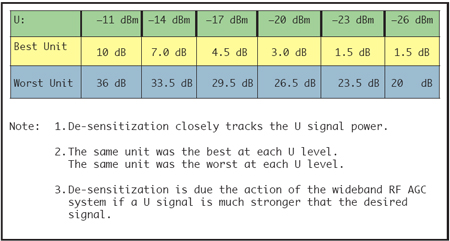Test Results for DTV-DTV Interference From ‘UHF Taboo Channels’

Charles W. Rhodes
Recently, my colleague Linley Gumm and I tested the robustness of NTIA-approved DTV converter boxes when subjected to a single undesired ATSC signal on what were formerly called “UHF taboo” channels. The FCC believed that DTV signals would not be subject to any interference from other than co-channel and (first) adjacent channels. A desired ATSC signal on, for example, Ch. 28 would not be jammed by another ATSC signal on Chs. 30, 32, 33, etc. This left former NTSC channels in the UHF band available for use by broadcasters displaced when Chs. 52–69 were auctioned. So far that repacking seems to have worked out well.
However, in the next repacking, up to 800 broadcasters assigned Chs. 31–51 will have to either find a still-vacant channel or share the 19.39 Mbps capacity of a 6 MHz channel below Ch. 31 or simply cease transmitting.
BEGS THE QUESTION...
Will this second repacking work? It all depends on how many broadcasters displaced by this repacking decide to seek a vacant channel in what is left of the TV spectrum after the next repacking. If, say, 600 broadcasters seek a vacant channel, they will be looking for a channel that is vacant and probably has taboo relationships to existing stations in that market.
Suppose, for example, Ch. 28 is presently vacant and that there is no Ch. 27 or 29 allotment within the FCC-prohibited distances from the broadcaster’s present transmitter. There certainly will be stations in his market on Ch. 30 and above, or on channels below 27.
Will their signals cause interference to reception of a DTV signal broadcasting on Ch. 28? Or, will a signal on Ch. 28 cause interference to existing stations in the community? If the displaced broadcaster’s transmitter happens to be co-sited with the other broadcasters, interference will generally not result.
But will each displaced broadcaster be able to find a vacant channel? He will have to be co-sited with the stations on those UHF taboo channels because some receivers would otherwise suffer interference.
The professional video industry's #1 source for news, trends and product and tech information. Sign up below.
Not all broadcasters are presently co-sited with each other. The FCC rules have no restrictions except those which protect against co-channel or adjacent channel DTV-DTV interference. So it would appear that any site could be used for a channel, which would not create co-channel or adjacent channel interference.

Table 1: De-sensitization of receivers tuned to Ch. 28 by one undesired ATSC signal on Ch. 30 Our tests demonstrated that DTV-DTV interference due to taboo channel relationships between desired (D) and undesired (U) ATSC signals will happen.
Table 1 shows the de-sensitization occurring to Ch. 28 (N) from a DTV signal on Chs. 30 (N+2) to 38 (N+10). We found interference from all, with Ch. 30 being the worst. De-sensitization in Table 1 is the difference between the minimum usable D signal power with the interference at the stated level and the minimum usable D signals power when there is no interference or multipath.
For example, at U = –20 dBm, the best unit suffered 3 dB of desensitization while the worst unit suffered 26.5 dB of desensitization. As the noise-limited D signal power (channel N) for our ATSC signal is about –85 dBm, with one U signal on N+2 at–20 dBm, the minimum required D signal power is 26.5 dB above –85 dBm or –58.5 dBm where the U signal power is –20 dBm.
This is a desired-to-undesired power ratio (D/U) of –38.5 dB. If these transmitters are co-sited, and well engineered, such large power differences would not exist and there would be no interference.
Wideband RF AGC circuits sense the total signal power at the RF input to the mixer. The gain of the RF amplifier is controlled to maintain the signal level at the mixer constant so that the mixer would not be overloaded and generate nonlinear distortion products.
In this way, interference by U signals on a channel adjacent to the D channel was greatly improved. This was important because it allowed the use of first adjacent channels in the same community, which had not been possible with analog signals.
A desired DTV signal can be received when it is as weak as –85 dBm absent interference and multipath. The ATSC believes that the strongest DTV signals at receiver inputs is about –8 dBm. In our experiments, we were able to approach this limit as Table 1 shows (–11 dBm).
DTV receivers may be subject to U signals on multiple UHF taboo channels. This is exactly the problem that broadcasters may find after the FCC repacks the TV spectrum. Table 1 clearly demonstrates that channels such as N+/–2 or +/–3 should not be allocated in the same community as Ch. N in the UHF band. With four U signals of about the same power, the desensitization increases by 4.7 dB.
Stay tuned.
Charles Rhodes is a consultant in the field of television broadcast technologies and planning. He can be reached via email atcwr@bootit.com.
